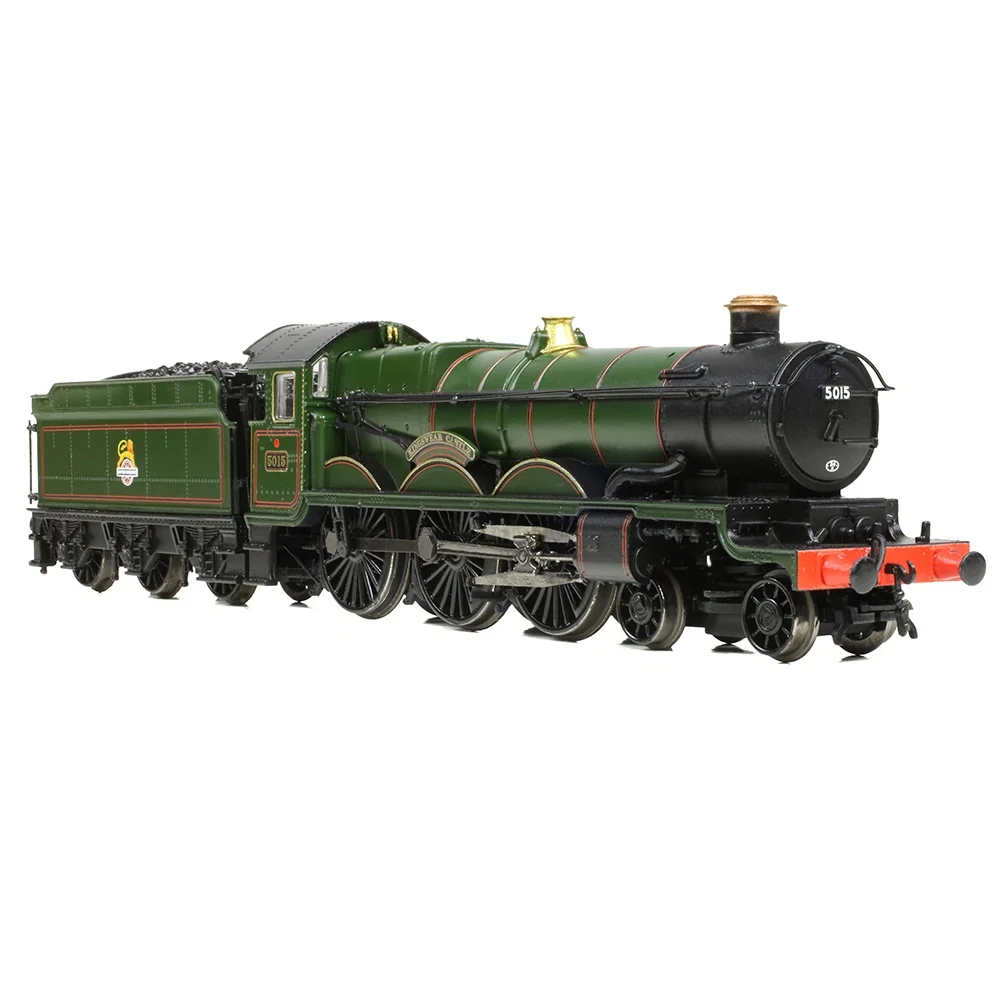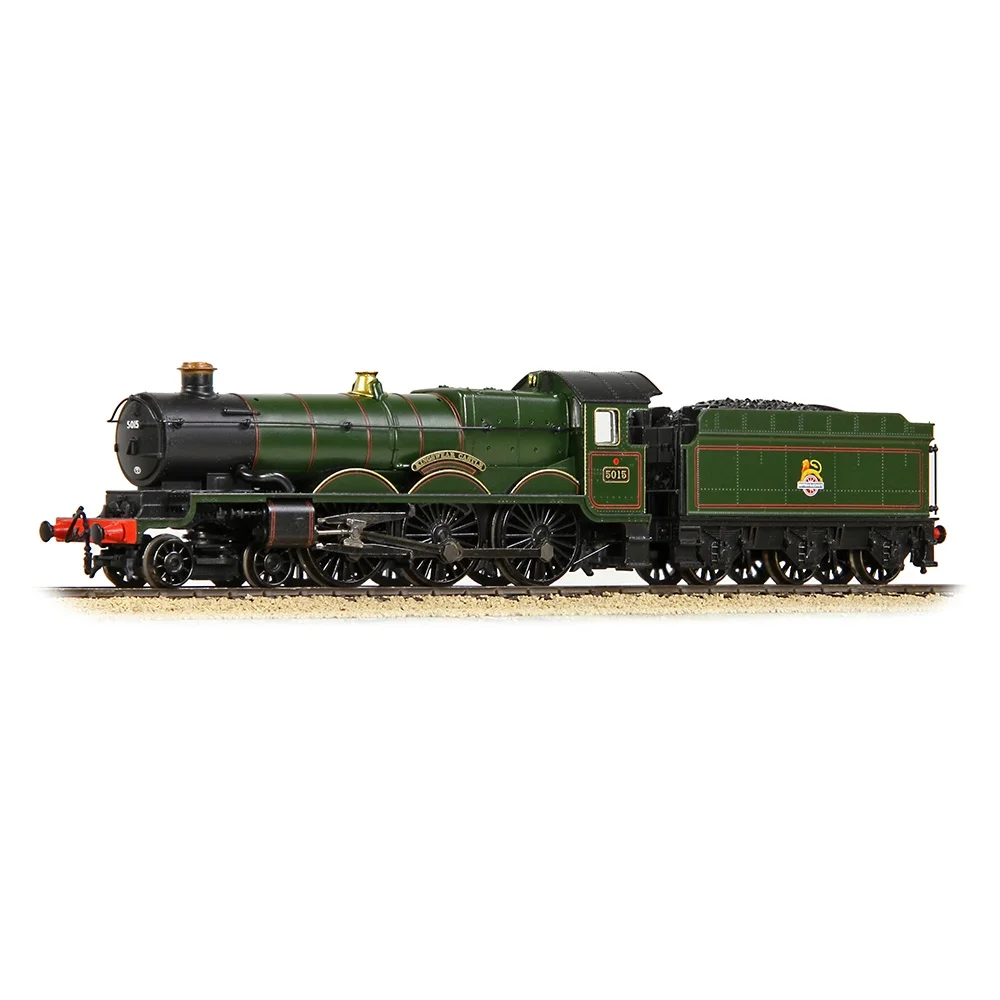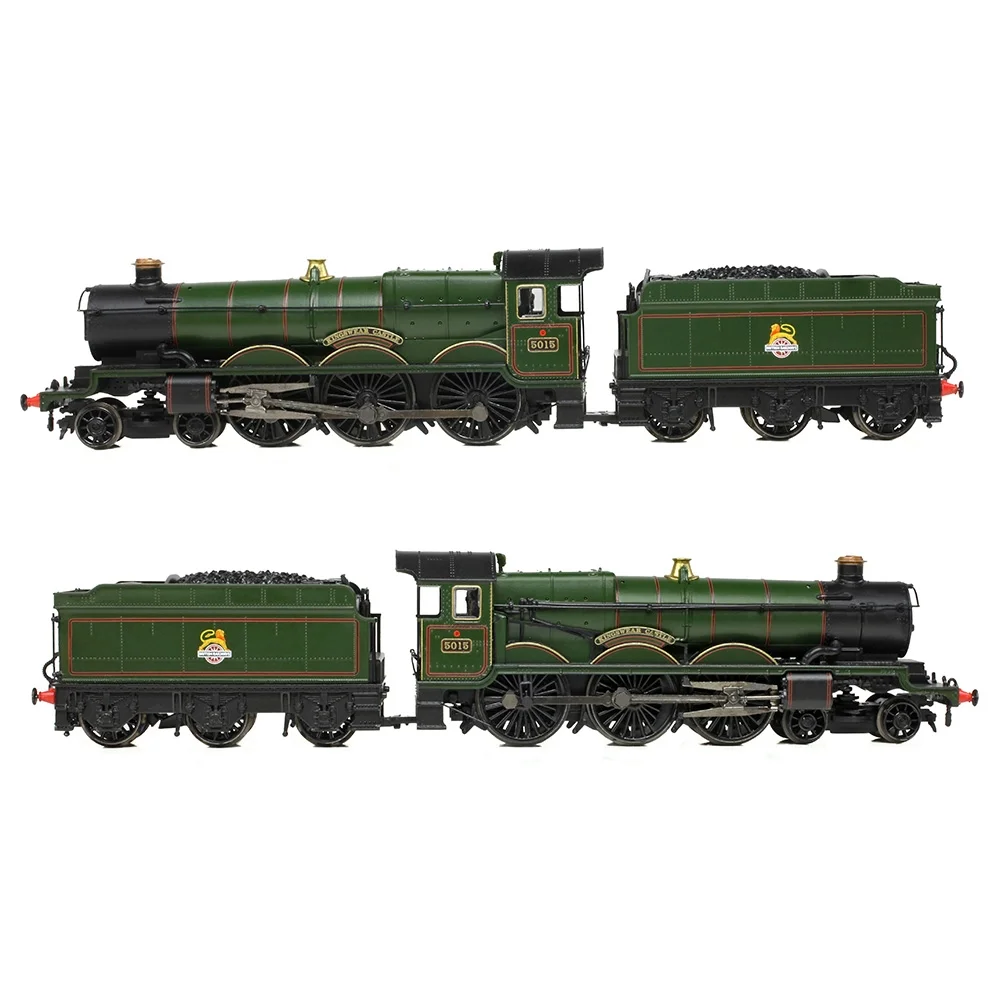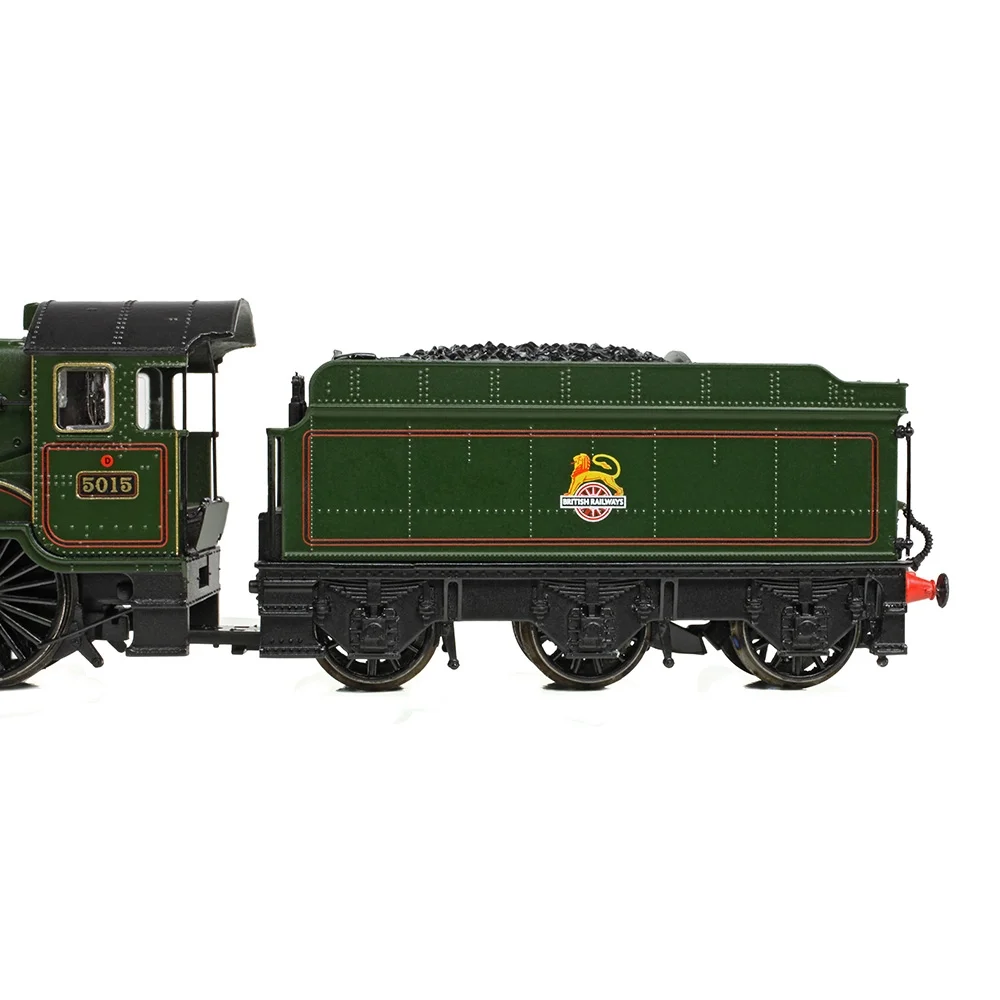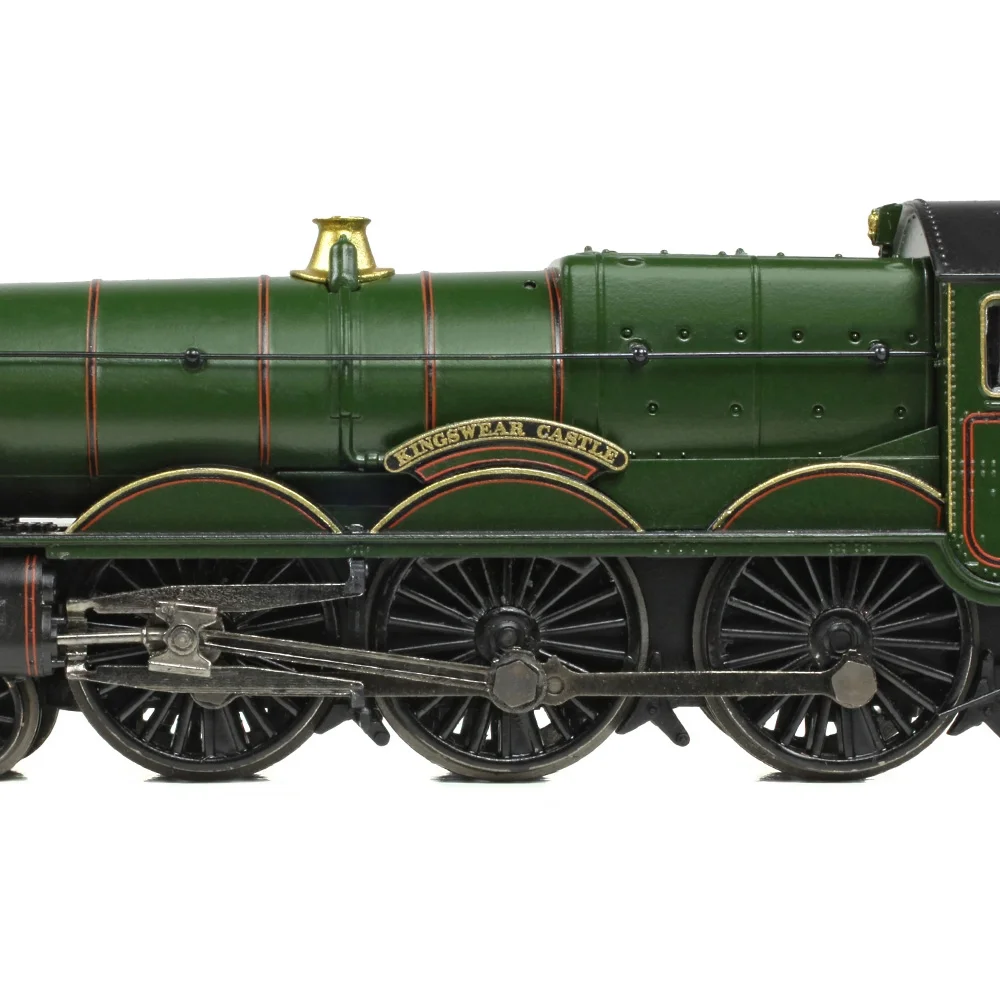Graham Farish 372-031A
Great Western Railway 4073 Class 5015 Kingswear Castle British Railways Lined Green with Early Emblem
Graham Farish's Description & Specifications
The Graham Farish Castle Class locomotive is a worthy replica of one of the Great Western Railway’s (GWR) finest steam locomotive designs, with its elegant appearance only amplified by the beautiful lined green livery that was synonymous with the GWR, and later British Railway’s Western Region. This N scale model combines the Castle’s good looks with an exquisite paint finish to produce a masterpiece in miniature fit for any Western-inspired collection.
The model that started a revolution as the first British N Scale steam locomotive to be made with SOUND FITTED, the Graham Farish ‘Castle’ has a technical specification as impressive as its good looks, with a powerful coreless motor driving the wheels through a diecast metal gearbox, all wheel pickup from the driving and tender wheels and separate metal bearings fitted to the driving wheel axles, smooth and reliable running is guaranteed. The tender houses a speaker and Next18 DCC decoder socket, making it easy to add sound, or opt for a SOUND FITTED version and the work is done for you, so you can enjoy realistic sound effects straight from the box on both Analogue and DCC.
- Graham Farish N Scale
- Era 4
- Pristine BR Lined Green (Early Emblem) Livery
- Running No. 5015
- Named ‘Kingswear Castle’
- Equipped with a Next18 DCC Decoder Socket – Recommend Decoder item No. 36-567A
- Length 145mm (over couplings)
DETAIL VARIATIONS SPECIFIC TO THIS MODEL
- Collett 4,000-gallon Tender
- Single Chimney
- Inside Cylinder Chest: Box Pattern with Straight Front
- Curved Cylinder Steam Pipes
- Tapered Buffers
- Horizontal Cab Side Handrail
- Rear Sandboxes Behind Cab Steps
- Short Nameplates
MECHANISM:
- Coreless motor
- Electrical pickup from all driving and tender wheels
- Separate metal bearings fitted to each driving wheel axle
- Metal bearings fitted to each tender wheel axle
- Diecast metal chassis block
- Diecast metal gearbox, with gearing arranged for prototypical running speeds and haulage capabilities
- 9mm (N gauge) wheels to NEM310 standards with authentic profile and detailing
- Traction tyres fitted to the rear driving wheels for assured haulage capabilities
- Valve gear of metal construction
- Discreet fixed locomotive to tender drawbar with integral electrical connections
- Coupling pocket to NEM355 standards fitted to the front bogie
- Removable coupling pocket to NEM355 standards fitted to the tender chassis
- Designed to operate on curves of second radius (263.5mm) or greater
DETAILING:
- High-precision, injection-moulded bodyshell, running plate and tender with separately fitted details parts including smokebox door, lower front lamp irons, steam pipes, whistle and reverser
- Separately applied metal components including handrails, buffers and sand pipes
- Dome, filler cap, water scoop and vacuum pipe added to the tender as separate parts
- Tender fitted with metal coal-effect load
- Detailed cab interior including boiler backhead controls and gauges, brake standard and water scoop standard
- Hinged and posable metal fall plate between the locomotive and tender
- Each model supplied with a full set of accessory parts including dummy screwlink couplings and front vacuum pipe
DCC:
- Next18 DCC decoder interface located in the tender
SOUND:
- Speaker installed in the tender of all models for optimum sound reproduction
- Zimo MS590N18 DCC Sound Decoder fitted to SOUND FITTED versions
- Sound files produced specifically for the Graham Farish GWR Castle Class using recordings from real locomotives
- SOUND FITTED models operate on DCC and Analogue control as supplied
LIVERY APPLICATION:
- Authentic liveries applied to all models
- Multiple paint applications employed on each model using GWR and BR specification colours
- Logos, numerals and text added as appropriate using multi-stage tampo printing using authentic typefaces, logos and colours
- Named locomotives are supplied with pre-fitted, fully decorated nameplates
Class & Prototype
- Class: Great Western Railway 4073 Class
- Traction: Steam
- Built: 1923-1950
- Total Built: 171
- Running Number: 5015
- Name: Kingswear Castle
- Ordered By: Great Western Railway
- Built By: Great Western Railway
- Built At: Swindon
- Built: 07/1932
- Withdrawn: 04/1963
- Length of Service: 30.8 years
- Running Numbers: GWR 5015
- Names: Kingswear Castle
The GWR 4073 Castle Class represents the pinnacle of Great Western Railway express passenger design, introduced by Charles Collett in 1923. These legendary 4-6-0 locomotives famously outperformed LNER Pacifics in the 1925 exchange trials, proving their superior fuel economy and performance. With 171 built between 1923-1950, they handled premier services like the "Cornish Riviera Express" for over four decades. Eight survive in preservation, with excellent model representations available from Hornby, Graham Farish, and specialist manufacturers. Essential for any authentic GWR layout.
GWR No. 5015 Kingswear Castle was built at Swindon Works in July 1932 as part of Lot 280, representing the second generation of Castle Class locomotives. This locomotive incorporated several technical improvements over earlier Castles, including a redesigned firebox with wider water spaces, individual 'J' hangers for the springs, and a distinctive 'square' inside cylinder cover with curved front edge. Built during the Great Depression era, 5015 served for nearly 31 years before withdrawal in April 1963. Like other locomotives in the 5013-5022 batch, it featured enhanced mechanical details including repositioned coupling rod joints, reinforced wheel webs, and improved sanding arrangements. Named after the historic artillery fort guarding Dartmouth harbour, this locomotive represents the refined Castle Class design that proved so successful throughout the 1930s and beyond.
This locomotive was part of the technical evolution of the Castle Class, incorporating the lessons learned from the first decade of operation while maintaining the fundamental design excellence that made the class so celebrated.
Operator & Livery
- Operator: British Railways
- Livery: Lined Green with Early Emblem
- Era: 4 - British Railways Early Emblem
British Railways transformed Britain's fragmented rail network into a unified national system following nationalisation on 1st January 1948. Created from the "Big Four" companies under the Transport Act 1947, BR operated most of Great Britain's railways until rebranding as British Rail in 1965, managing over 20,000 route miles and inheriting nearly 20,000 locomotives of diverse designs.
The organisation pioneered standardisation through its revolutionary BR Standard locomotive programme (1951-1960), producing 999 advanced steam engines under Robert Riddles' direction. These included the versatile Britannia Pacifics, mighty 9F freight engines, and mixed-traffic classes that incorporated the best features from all predecessor companies. The 1955 Modernisation Plan accelerated diesel and electric traction development, creating fascinating mixed-traction operations.
Notable achievements included establishing unified locomotive classification systems, introducing distinctive corporate liveries, and managing the complex transition from steam to modern traction. BR's six regional structure preserved operational diversity whilst enabling standardisation of practices, signalling, and rolling stock that had eluded private enterprise for over a century.
The BR era represents steam traction's final flowering alongside emerging diesel technology, creating unparalleled locomotive variety. Today, this heritage remains highly popular with railway enthusiasts through extensive preserved fleets, heritage railway operations, and comprehensive model ranges from manufacturers like Hornby, Bachmann, and Dapol, making BR subjects essential for authentic post-war British railway modelling across all scales.
British Railways' lined green livery was designated for express passenger locomotives from 1949, painted in BS224 Deep Bronze Green (also known as Land Rover Deep Bronze Green) with orange and black lining, contrary to popular misconceptions about it being GWR Brunswick Green. Official BR documentation described this as "Dark Green lined Black and Orange" for selected express passenger steam locomotives, with the lining following GWR-style patterns but with distinct BR specifications. The "Lion and Wheel" emblem (nicknamed the "Cycling Lion") adorned these prestigious locomotives from early 1949, showing a lion standing over a spoked wheel with "British Railways" lettering across the centre.
Only the most powerful passenger classes received this elaborate livery—on the Western Region, this included Kings, Castles, and Stars, whilst other regions applied it to their premier express types like Coronations, A4s, A3s, A1s, and Merchant Navy Pacifics. Initially, the most prestigious locomotives of each region were actually painted in Sky Blue with black and white lining, but this proved unpopular and was quickly superseded by the green scheme. The emblem was positioned centrally on tender sides above the middle axle box, with regional variations in size preference—the Western Region favoured larger emblems whilst other regions typically used smaller versions. Lettering and numbering appeared in golden yellow Gill Sans Medium, normally outlined in black where the background wasn't black. This prestigious livery represented BR's finest locomotives until the corporate identity changed in 1956, making it essential for authentic early BR express passenger operations in model form.

